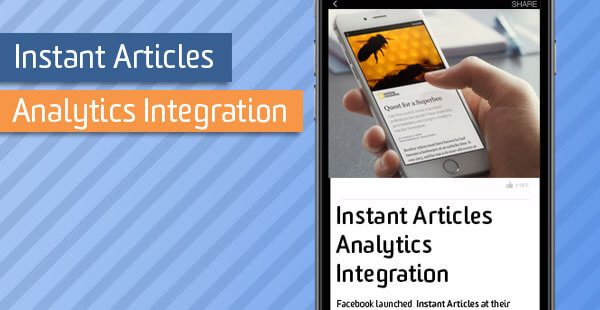Instant Articles Analytics Integration

Instant Introduction
Facebook launched Instant Articles at their F8 conference this year. Instant Articles allow a stripped-down version of your content designed by you to be shown when Facebook users click on your content within Facebook. The concept, to increase page load speed for the end-user, is similar to Google’s AMP, and similarly requires ads and analytics to be handled specially.
Instant Incipience
Why take the time to publish Instant Articles over leaving a plain-ol’ link in Facebook? Because Facebook’s been throwing around some big numbers:
- 10X – Faster than standard mobile web articles.
- 20% – More Instant Articles read on average.
- 70% – Less Likely to Abandon the Article.
And considering you can put your own ads in the Instant Article, which Facebook won’t take a cut, the increase in audience engagement can be important. In order to see exactly how Instant Articles are performing for you, analytics are required. Fortunately, publisher can include their own analytics and ad code.
Instant Installments
Before we can measure engagement, we must have something to be engaged with! To publish Instant Articles, you need a Facebook Page to publish them on. Currently, you need a minimum of 10 articles to publish and your initial batch must be approved by Facebook and match their markup format (a subset of HTML5) before they appear live. Another note is that publishing an Instant Article does not publish the article to your Facebook Page; it simply makes it possible to show the Instant Article when a user encounters a link to the Instant Article’s canonical URL. However, many of these details don’t matter, as there are plugins for a variety of blogging engines such as WordPress and Drupal to publish Instant Articles seamlessly, otherwise a specially formatted RSS feed can be used for those using other platforms, such as Jekyll.
Instant Information
(OK, maybe we can’t get all the analytics instantly.) Now that the user has something to read, we can measure how much reading they do! In Instant Articles, tracking is placed within a <figure class="op-tracker"><iframe></iframe></figure> block. Facebook sets the document location of the iframe to the Instant Article’s canonical URL (the one for the version of it on your site), and prevents the user from seeing the iframe. By virtue of being an iframe, it prevents the code from affecting the page or listening to events, which rules out scroll and video tracking along with any user-triggered events.
A major caveat, but not limitation, is that by default pageviews will appear with a source of direct. To differentiate where this traffic is coming from, your analytics code should set the information you care about, e.g. source cs, medium cm, and/or a custom dimension cdX. The source and medium can be set similar to the UTM tags that you would normally use on posts you share on Facebook, or to something that will distinguish Instant Article views from click-throughs, e.g. source=instant-article and medium=facebook. The social and custom dimension can be set if that is something you are currently reporting on.
Instant Inquiries
While many of the more advanced measurement strategies, such as scroll and video tracking, aren’t available, we need to focus on the basics: pageviews, and potentially timer events. Going back to the basics, however, will still yield enough information to help determine how users are engaging with your Instant Articles.
There are still many questions to explore, and we’re excited to investigate them in order to enable better analytics in Instant Articles. These insights can help understand how your content is interacted with on the Facebook platform.


